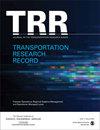研究极端天气条件下高速公路上轻型车辆交通量的季节变化:时间统计和数据挖掘非参数技术的结合
IF 1.8
4区 工程技术
Q3 ENGINEERING, CIVIL
引用次数: 0
摘要
如今,随着天气模式的不断变化以及高速公路网络不同部分与天气和交通相关的大量数据,使用数据挖掘方法来量化天气对交通流的影响是不可避免的。本研究的主要目的是提出一种地质统计学方法,用于计算和分析天气变量的基本和极端情况对高速公路上轻型车辆交通量的影响,重点是一周中不同日子和昼夜之间的时间变化。在本文提出的统计分析方法中,采用了双向方差分析的参数检验。在此基础上,基于分类回归树(CART)决策树算法的非参数化方法,对不同季节对交通量影响最大的天气相关参数分别进行了研究。为此,对所研究的高速公路9年的交通和天气数据进行了分析。计算结果表明,寒冷季节工作日气温下降35%以上,春季水平能见度、白天降雨量、夜间气温等参数对车流量的影响大于45%。该研究表明,数据驱动的参数和非参数数据挖掘技术的结合对极端天气条件下的交通规划和交通控制是有效的。为此,提出了一种恶劣天气条件动态信息标志(AWCDMS)框架,作为对驾驶员进行恶劣天气预警的实用方法。本文章由计算机程序翻译,如有差异,请以英文原文为准。
Examining Seasonal Changes in Light-Vehicle Traffic Volume on Freeways Under Extreme Weather Conditions: A Combination of Temporal Statistical and Data Mining Non-Parametric Techniques
Today, with the increasing changes in weather patterns and the huge amount of data related to weather and traffic in different parts of the freeway network, the use of data mining methods to quantify the impact of weather on traffic flow is inevitable. The main objective of this study is to present a geostatistical method for computing and analyzing the effects of base and extreme cases of weather variables on light-vehicle traffic volumes on freeways, with an emphasis on temporal changes on different days of the week and between daytime and nighttime. In the proposed method for statistical analysis, the parametric test of two-way analysis of variance was used. In the following, with the development of a nonparametric method based on the classification and regression tree (CART) decision tree algorithm, the weather-related parameters with the greatest effect on traffic volumes were investigated separately for different seasons. For this purpose, nine years of statistics covering traffic and weather data for the studied freeway were analyzed. The computational results show that a fall in temperature of more than 35% on weekdays during the cold season and the parameters of horizontal visibility and rainfall during the day and temperature during the night in the spring cause a reduction of traffic volume of more than 45%. This study has shown that the combination of data-driven parametric and nonparametric data mining techniques is effective for traffic managers in planning and traffic control under extreme weather conditions. In this regard, an adverse weather conditions dynamic message sign (AWCDMS) framework was proposed as a practical way to warn drivers of adverse weather.
求助全文
通过发布文献求助,成功后即可免费获取论文全文。
去求助
来源期刊

Transportation Research Record
工程技术-工程:土木
CiteScore
3.20
自引率
11.80%
发文量
918
审稿时长
4.2 months
期刊介绍:
Transportation Research Record: Journal of the Transportation Research Board is one of the most cited and prolific transportation journals in the world, offering unparalleled depth and breadth in the coverage of transportation-related topics. The TRR publishes approximately 70 issues annually of outstanding, peer-reviewed papers presenting research findings in policy, planning, administration, economics and financing, operations, construction, design, maintenance, safety, and more, for all modes of transportation. This site provides electronic access to a full compilation of papers since the 1996 series.
 求助内容:
求助内容: 应助结果提醒方式:
应助结果提醒方式:


